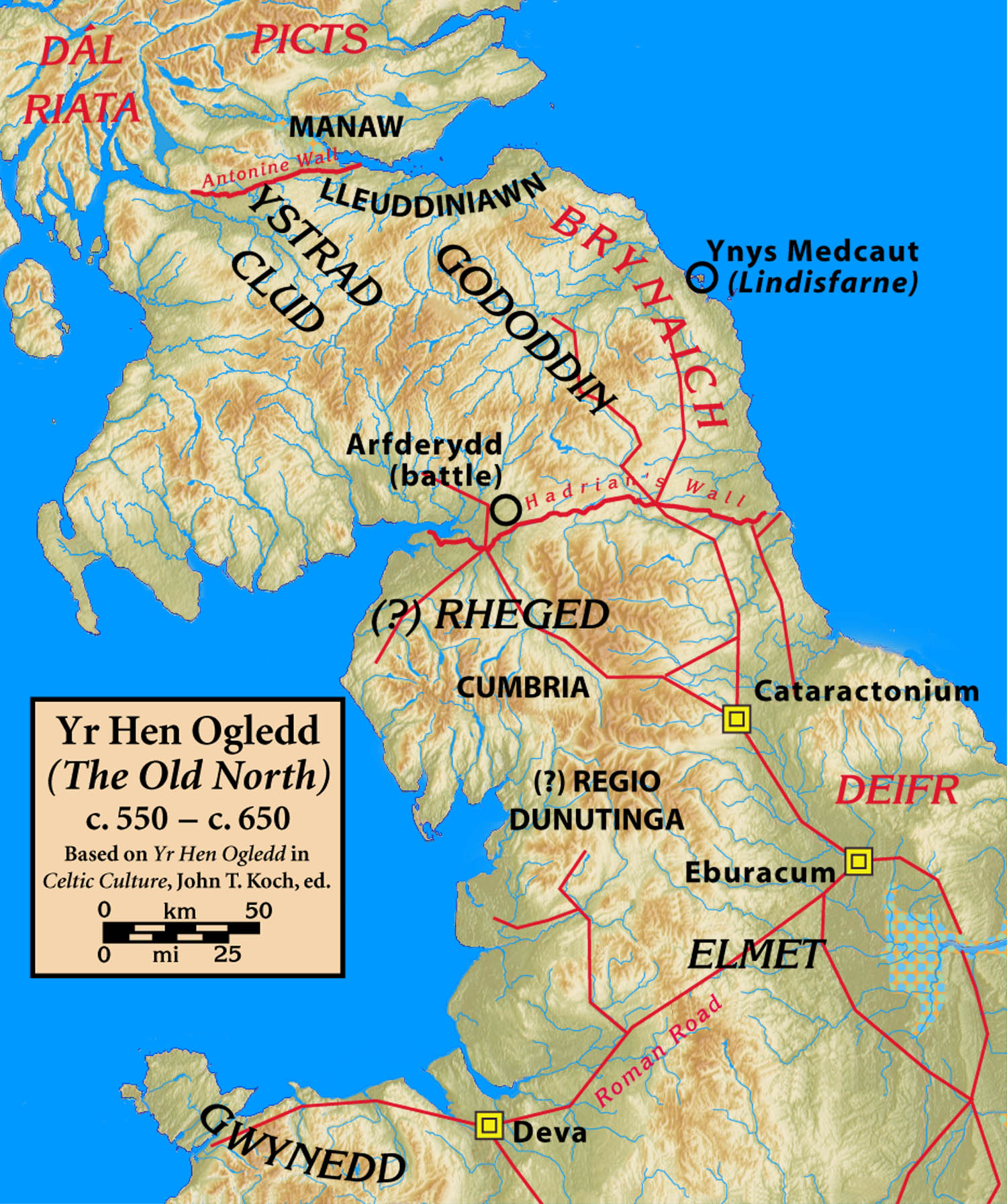
Hen Ogledd
Yr Hen Ogledd (Welsh pronunciation: [ər ˌheːn ˈɔɡlɛð]), meaning the Old North, is the historical region that was inhabited by the Brittonic people of sub-Roman Britain in the Early Middle Ages, now Northern England and the southern Scottish Lowlands, alongside the fellow Brittonic Celtic Kingdom of Elmet. Its population spoke a variety of the Brittonic language known as Cumbric which is closely related to, if not a dialect of Old Welsh. The people of Wales and the Hen Ogledd considered themselves to be one people, and both were referred to as Cymry ('fellow-countrymen') from the Brittonic word combrogi. The Hen Ogledd was distinct from the parts of Great Britain inhabited by the Picts, Anglo-Saxons, and Scoti.
The major kingdoms of the Hen Ogledd were Elmet, Gododdin, Rheged, and the Kingdom of Strathclyde (Welsh: Ystrad Clud). Smaller kingdoms included Aeron and Calchfynydd. Eidyn, Lleuddiniawn, and Manaw Gododdin were evidently parts of Gododdin. The later Angle kingdoms of Deira and Bernicia both had Brittonic-derived names, suggesting they may have been Brittonic kingdoms originally. All the kingdoms of the Hen Ogledd except Strathclyde were gradually either integrated or subsumed by the emerging Anglo-Saxon kingdoms, Gaelic Scots and fellow Brittonic Picts by about 800; Strathclyde was eventually incorporated into the rising Middle Irish-speaking Kingdom of Scotland in the 11th century.
The memory of the Hen Ogledd remained strong in Wales after its fall, and indeed the term came into being in Wales after the destruction of the Brittonic kingdoms of the north. Welsh tradition included genealogies of the Gwŷr y Gogledd, or Men of the North, and several important Welsh dynasties traced their lineage to them. A number of important early Welsh texts were attributed to the Men of the North, such as Taliesin, Aneirin, Myrddin Wyllt, and the Cynfeirdd poets. Heroes of the north such as Urien, Owain mab Urien, and Coel Hen and his descendants feature in Welsh poetry and the Welsh Triads.
Welsh tradition[edit]
One of the traditional stories relating to the genealogies of Welsh dynasties derived from Cunedda and his sons as "Men of the North". Cunedda himself is held to be the progenitor of the royal dynasty of the Kingdom of Gwynedd, one of the largest and most powerful of the medieval Welsh kingdoms, and an ongoing connection to the Hen Ogledd. Cunedda genealogy shows him as a descendant of one of Magnus Maximus' generals, Paternus, who Maximus appointed as commander at Alt Clut. The Welsh and the Men of the North saw themselves as one people and the Welsh name for themselves, Cymry, derives from this ancient relationship although this is debatable as while Gwynedd seemed to have good relationships with them along with Ceredigion but it is unknown how the other Welsh Kingdoms saw them as they were not unified themselves, especially the southern Kingdoms like Dyfed and the Ystrad Tywi who had heavy Irish presence at the time. 'Cymry' was a term that referred to both the Welsh and the Men of the North but was sometimes applied to others as well such as the Picts and the Irish.[8][9][10] It is derived from the Brittonic word combrogoi, which meant "fellow-countrymen", and it is worth noting in passing that its Breton counterpart kenvroiz still has this original meaning "compatriots". The word began to be used as an endonym by the Men of the North during the early 7th century (and possibly earlier),[11] and was used throughout the Middle Ages to describe the Kingdom of Strathclyde. Before this, and for some centuries after, the traditional as well as the more literary term was Brythoniaid, recalling the still older time when all on the island remained a unity. Cymry survives today in the native name for Wales (Cymru, land of the Cymry), and in the English county name Cumbria, both meaning "homeland", "mother country".
Many of the traditional sources of information about the Hen Ogledd survive in Welsh tradition, and bards such as Aneirin (the reputed author of Y Gododdin) are thought to have been court poets in the Hen Ogledd.